This was published 5 years ago
Okavango Delta safari: Botswana is Africa's great success story
By Nina Karnikowski
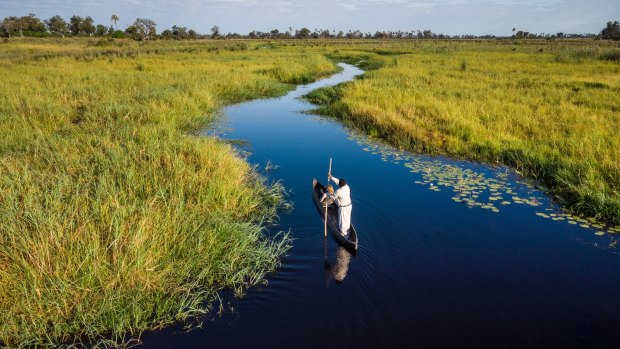
The Okavango River spreads over the delta and transforms the parched landscape into a luminous tapestry of greens and golds from May to October each year. Credit: Sanctuary Retreats
As our eight-seater light aircraft flew low over Botswana's Okavango Delta I spotted my first elephant, alone and slurping from a waterhole haloed by ochre trails. Minutes later, our group was stepping onto a dusty airstrip where a safari jeep awaited beside a table laden with champagne. As we toasted to impending adventure, a wildebeest studied us from just metres away.
It was one of those near-perfect safari moments and the ideal introduction to our Luxury Escapes itinerary in Botswana, where nature and luxury dance better together than almost anywhere on the planet. Before leaving Australia, I'd heard this middle-income African nation of 2 million referred to as the king of safari. After just a few minutes in the country, I was beginning to understand why.
Before independence from Britain in 1966, this little landlocked country was one of the poorest on earth. But after democratic rule was introduced, and a lucrative stash of diamonds was discovered the following year in 1967, the country experienced greater economic growth than any other country in the world. Then in 1993, the government began leasing companies land on which to build lodges, thus beginning Botswana's hugely successful low-volume, high-cost and high-value safari model. Lodges must keep guest numbers small, structures need to be easily disassembled, and short 15-year leases keep standards high.
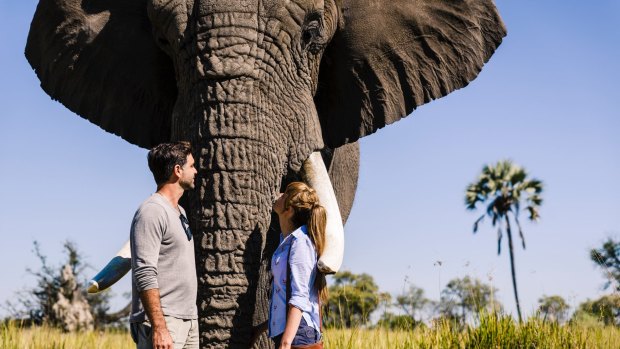
Meeting a local.
Stanley's Camp, a wonderfully old school tented camp run by Sanctuary Retreats where we soon arrived, is just one of the 90 or so lodges scattered throughout the Okavango Delta today. After a moving arrival song sung by the staff choir in Setswana, we were shown into the main dining-lounge area for welcome drinks, a sprawling canvas pavilion supported by wooden beams with panoramic views over the emerald floodplains. A cocktail bar surrounded by wooden decking and banquette seating beckoned. Before my husband and I knew it we were two Amarula liqueurs in, the stars were blazing and a gourmet barbecue dinner was being served by the campfire on the lawn. Hours later, we fell into bed in our tent – one of just eight set on a 105,000-hectare private concession, with indoor showers, ceiling fans and large wooden decks – feeling more satisfied than we could remember.
The Okavango Delta, the world's largest inland delta set at the heart of the forbidding Kalahari Desert, is Botswana's biggest drawcard. It's flooding, which happens when summer rains from the Angola highlands drain into the Okavango River and spread over the delta, transforms the parched landscape into a luminous tapestry of greens and golds from May to October each year. The area becomes an extraordinary hive of activity as wildebeest, buffalo, zebra, elephants, hippos and more arrive by the thousands, putting on one of the greatest wildlife shows on earth.
Our visit came in late March. The rains hadn't yet arrived, but still our sunrise game walk the following day saw us surrounded by palm trees, long dew-glistened grasses and towering sausage trees. Our armed guide pointed out mongoose, impala and hippo prints squished into the moist earth, acacias so spiky they could pierce a car tyre, bungalow-sized termite mounds and a hundred-year-old Baobab tree.
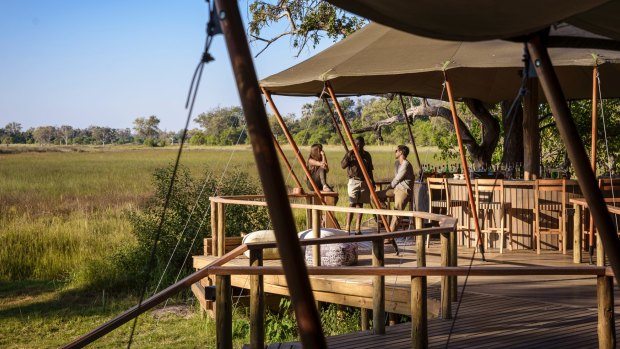
Lodges in the Okavango Delta are small and high quality.
With safaris being Botswana's second biggest earner after diamonds, conservation is taken extremely seriously.The president banned hunting on public land in 2014 and, in the same year, pushed for the delta's UNESCO World Heritage listing. While Africa's elephant population has diminished by a third in the past eight years, 130,000 of the remaining 350,000 have sought refuge in Botswana, making it Africa's largest elephant population.
The following day we meet two of these gentle pachyderms, Jabu and Morula, and the inspiring couple who rescued and have been looking after them in the wild for almost three decades, Doug and Sandi Groves (Sanctuary Retreats works with Doug and Sandi's Living With Elephants Foundation). We walked beside Jabu and Morula and listened to them communicate, rumbling back and forth at a volume that made our chests rattle. We felt the coarse hair on their tails, learnt about their habits and watched them rip branches the length of our bodies from trees as a light snack. After spending just a few hours with them, we became elephant ambassadors for life.
Mother Nature's show, however, was just beginning. That afternoon, we were poled through the tranquil waters of the delta on a fibreglass replica of a traditional wooden mokoro canoe by a man named Onks, who told us riddles as dragonflies filled the apricot sky. Next morning, we took another small bush plane to Chobe National Park. A completely different forest habitat – home to about 80,000 of Botswana's 130,000 elephants and the infinitely tasteful Sanctuary Chobe Chilwero lodge with views over the Chobe River – awaited.
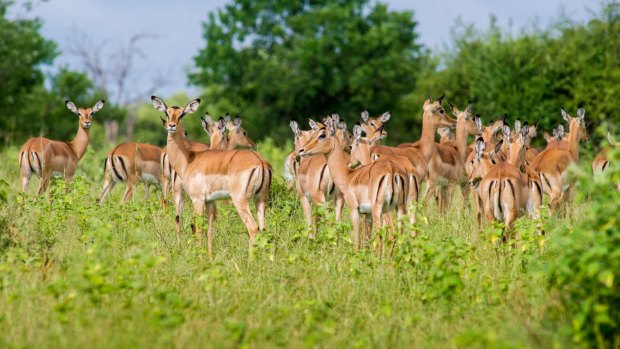
Impala in Chobe National Park.Credit: Alamy
Our local guide Mushe whizzed us through the park on captivating twice-daily game drives. Saggy-bottomed elephants raced across the dirt track in front of our vehicle, grumpy buffalos with horns like 50s hairdos hid in the bushes, as iridescent lilac-breasted rollers flitted past. We stopped for tea and fuzzy grey vervet monkeys tried to steal our snacks; we watched in horror as a snouted cobra swallowed a puff adder whole; we drank sundowner beers and nibbled impala samosas on the front of our jeep. On a late afternoon motorboat cruise, we peered through binoculars across the sun-scattered water at yawning hippos, elephants drinking and bathing, and crocodiles leering tight-toothed grins on the muddy banks. Pure Huck Finn pleasure, at every turn.
On our final evening in Botswana, we arrived back at our thatched cottage to find the bathtub had been filled, a bottle of champagne chilling by its side. We opened the bathroom doors to the courtyard, slipped under the warm water and, to the soundtrack of the frogs and the night birds, toasted to this African success story.
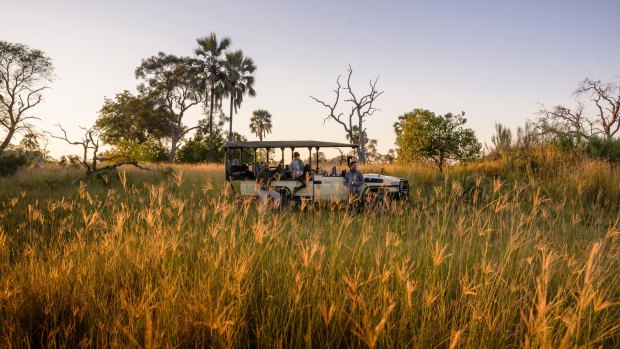
On safari in the Okavango Delta.Credit: Sanctuary Retreats
FIVE OTHER GREAT THINGS TO SEE IN BOTSWANA
VISIT THE DESERT KING
Inside the immense Central Kalahari Game Reserve you'll find the elusive Kalahari lion, alongside wild dog, springbok, hyena and more. Four-wheel drive, walking and horseback safaris are all available.
WALK WITH BUSHMEN
Walking in the desert with the Kalahari's San people, Southern Africa's oldest inhabitants dating back at least 20,000 years, will give you an insight into their extraordinary knowledge of the area.
SEE THE SALT PANS
One of the world's largest salt pans, the usually dry and clay-encrusted Makgadikgadi becomes covered with water and grass in the rainy season, and is surrounded by huge herds of migrating springbok, zebra, hartebeest and more.
CHECK OUT THE 'LOUVRE OF THE DESERT'
The Tsodilo Hills near the Namibian border have one of the world's highest concentrations of rock art, with more than 4500 paintings from the Stone Age through to the 19th century covering a 10-kilometre area.
PAY BAINES' BAOBABS A VISIT
Compare the famous Baines' Baobabs paintings, immortalised by artist and adventurer Thomas Baines in 1862, with the real thing in Nxai Pans National Park, and you'll see that in almost 150 years only one branch has broken off.
TRIP NOTES
MORE
FLY
Qantas flies from Sydney to Johannesburg. From there, South African Airways connects to Maun, the safari starting point for north and central Botswana, and to Kasane, close to Chobe National Park. See qantas.com
TOUR
Luxury Escapes offer an 11-night small group safari taking in Zambia, Botswana and South Africa, including luxury accommodation with Sanctuary Retreats, all meals and beverages, the "Flight of the Angels" helicopter ride over Victoria Falls, the "Walking with Elephants" experience and more, from $8499 per person. See lescapes.com
Nina Karnikowski travelled as a guest of Luxury Escapes.
Sign up for the Traveller Deals newsletter
Get exclusive travel deals delivered straight to your inbox. Sign up now.